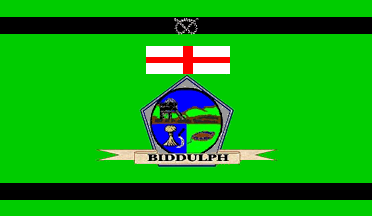![[Flag of Staffordshire]](../images/g/gb-e)stf.gif) located by Adrian Thomas
located by Adrian Thomas
Last modified: 2005-12-31 by rob raeside
Keywords: staffordshire | kidsgrove | biddulph |
Links: FOTW homepage |
search |
disclaimer and copyright |
write us |
mirrors
![[Flag of Staffordshire]](../images/g/gb-e-stf.gif) Adrian Thomas, 16 March 2003
Adrian Thomas, 16 March 2003
See also:
On a green field, the coat of arms of the county (an enlarged version can be
seen below): on the chevron gules a
Staffordshire Knot of the first on a chief azure a lion passant guardant of the
field and for the crest issuant out of a mural crown proper a Stafford knot or
as same are in the margin hereof more plainly depicted. And by the authority
afore said I the said garter do these presents grant and assign the supporters
following that is to say on the dexter side a lion reguardant gules crowned with
a ducal coronet or and on the sinister side a Gryphon reguardant or as the same
are also in the margin hereof more plainly depicted the whole to be borne and
used for hereafter by the Stafford county.
Adrian Thomas, 16 March 2003
 image by Adrian Thomas, flag designer
image by Adrian Thomas, flag designer
The flag is green with two horizontal black stripes, the upper one containing a Stafford knot. The shield of the town bears a round seal, divided per fess, above a colliery scene, below divided per pale on the left a sheaf and sickle on blue, on the right a brown shuttle on green. Behind the seal is a grey pentagon, and over all is a ribbon stating BIDDULPH. Above the shield is a St. George's cross flag.
A flag for the town of Biddulph, Staffordshire, can be seen on
the webpage at
http://www.nigelmachin.co.uk/biddulph/ten.htm. I designed it for the
town council. The black stripes represent the coal mining industry, and the
green field the green of Biddulph Moor. The St. George's cross flag on the
Biddulph flag is because the town is in England.
Adrian Thomas, 24 December 2005
One line (and only one line) in a report of a Town Council meeting on the web
site of the Biddulph Chronicle states as follows: "The design for the Biddulph
flag was chosen from the examples submitted." This report is dated 18th
February, but no year is provided.
Colin Dobson, 26 December 2005
![[Flag of Kidsgrove]](../images/g/gb-e-kdg.gif) image by
Adrian Thomas, flag designer, 9 January 2003
image by
Adrian Thomas, flag designer, 9 January 2003
The flag was adopted in October 2002 by the Kidsgrove Council after many
designs were considered. The flag consists of two horizontal bands. The top band
is blue which represents the Trent and Mersey canal that runs through the town
bringing business and commerce. Blue is also representative of the sky. The
green represents the GROVE as on the name of part the town. The crest has the
Staffordshire knot for the county of Staffordshire. It also has the Second World
War spitfire fighter plane which was designed by Reginald Mitchell, a Kidsgrove
Native and legend. The lower part of the crest has goats (kids) in a grove hence
the name Kidsgrove. The year of 1895 was the year numerous small villages became
unified into one town. Located in the top left canton is the Union Flag because
we are a town in Britain. The dimensions of the official flag is 6' x 3'6" but
can also be 5' x 3'. The flag will be flown at the Town Hall on special events.
The flag will also be flown at local business', football club, scout facilities
and town residence. I brought the idea to the Kidsgrove Council after noticing
that many European towns and cities have flags of their own. The council agreed
to the idea and asked that I summit some designs. After some deliberation, they
chose the enclosed design. Kidsgrove is situated on the border of Cheshire and
the most northern part of Staffordshire. Because of this, I felt a flag of our
own would provide us with our own identity. We are now twinned with a French
town, St. Paul du Bois. Delegates from that town will be coming to Kidsgrove at
the end of February and will be presented with an official flag at the welcoming
reception.
Adrian Thomas, 9 January 2003